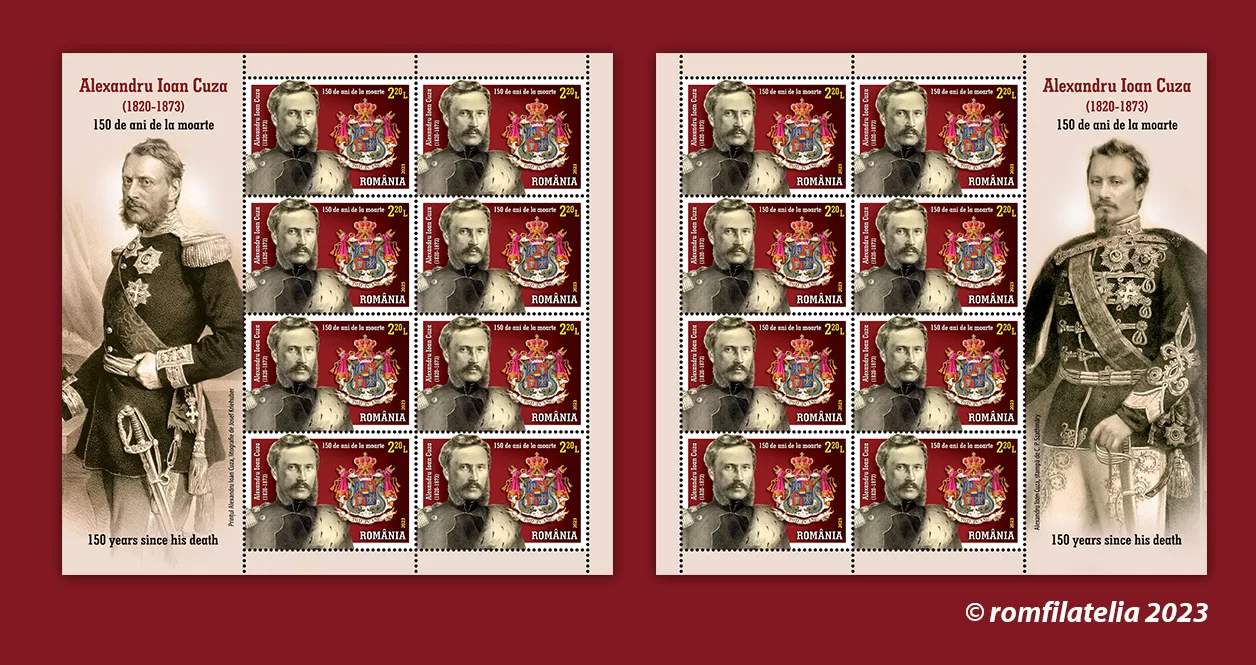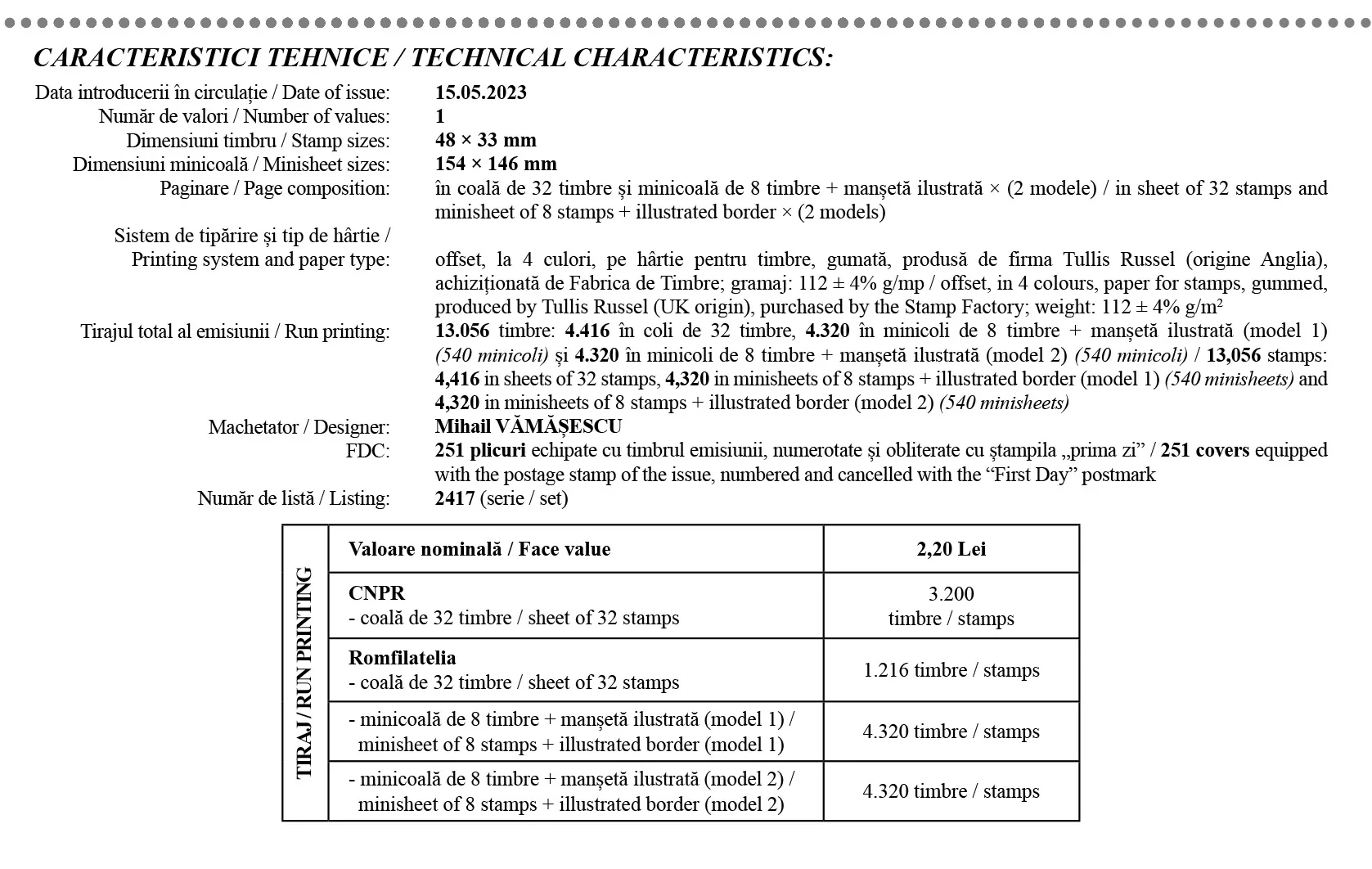 On the occasion of the one and a half century anniversary of the passing to eternity of the Ruler Alexandru Ioan Cuza, Romfilatelia introduces into circulation on Monday, May 15th this year, the issue of postage stamps entitled Alexandru Ioan Cuza. 150 years since death, consisting of a postage stamp and a First Day Cover.
On the occasion of the one and a half century anniversary of the passing to eternity of the Ruler Alexandru Ioan Cuza, Romfilatelia introduces into circulation on Monday, May 15th this year, the issue of postage stamps entitled Alexandru Ioan Cuza. 150 years since death, consisting of a postage stamp and a First Day Cover.
The stamp with the face value of Lei 2.20 of the issue reproduces in the image of the postage stamp a less used portrait of the ruler, in a graphic ensemble in which the image of the coat of arms of the Union of Romanian Principalities is also associated.
The First Day Cover has as its main compositional element a photograph of the ruler taken by the well-known photographer and painter Carol Popp de Szathmáry, inserted in a background in which the image of the coat of arms of the Union shines through.
The “first day” postmark reproduces a stylized portrait framed between the figures indicating the year of birth and death, respectively of the first ruler of the United Principalities.
Alexandru Ioan Cuza was born on March 20th, 1820. The year 1831 found him at the end of his schooling at Victor Cuenin French boarding school, in Iasi, together with colleagues Mihail Kogălniceanu, Vasile Alecsandri and Matei Millo. He continued his studies in Paris in 1835, graduating from the Sorbonne with a diploma signed by François Guizot.
Returning to the country after the failure of the Revolution of 1848, when the ruler of Moldavia was Grigore Ghica, a personality with liberal views and supporter of the Union, he was appointed president of the Covurlui Court and later (in 1851), director in the Ministry of Interior, receiving the rank of Vornic (steward).
A patriot with broad liberal ideas, Cuza’s personality would attract the support of the Unionists. On January 5th, 1859, the Elective Assembly of Moldavia unanimously elected him as ruler. On January 24th, 1859, the Elective Assembly of Wallachia also voted to elect Alexandru Ioan Cuza as ruler. This double election brought about the Union of the Romanian Principalities, thus laying the foundations for the future unitary and modern Romanian state.
On January 25th, 1859, Al. I. Cuza addressed a diplomatic note to the guarantor powers announcing “the complete union of the Principalities that the Romanian nation wanted to found”.
In order to simplify the way of law-making and the implementation of reforms, Cuza manages to create a single parliament and a single government with a permanent seat in a single capital, Bucharest. It was 1862, the year the name Romania was adopted for the country.
The ruler had at his side Mihail Kogălniceanu, who, as Prime Minister between 1863 and 1865, was a political personality whose recognized authority allowed him to implement the most important reforms, aimed at bringing Romania among the modern States of Europe.
Agrarian reform, tax reform, education reform (establishment of the Universities of Bucharest and Iași), reforms in culture, army and administration place the Ruler Alexandru Ioan Cuza as the first reformer of the modern Romanian State.
On February 23rd, 1866, Alexandru Ioan Cuza is forced to abdicate due to so-called political reasons. In reality, the “boyars” had had a hard time accepting the many reforms that had been implemented.
Living in exile in Germany with a heart condition, Alexandru Ioan Cuza died on May 15th, 1873, being finally brought back to the country and buried at the Royal Church of Ruginoasa, where he had his mansion-palace.
Later, his remains were moved to The Three Hierarchs Church in Iasi. At his coffin, his best advisor. Mihail Kogălniceanu, was to declare: “It was not the mistakes, but the great deeds of Cuza Vodă that brought about his dethronement”.
Romfilatelia thanks the representatives of the Iași City Hall, of the Bucharest Municipality Museum and of the “King Ferdinand I” National Military Museum for the documentary and photographic support granted to the development of this issue of postage stamps



